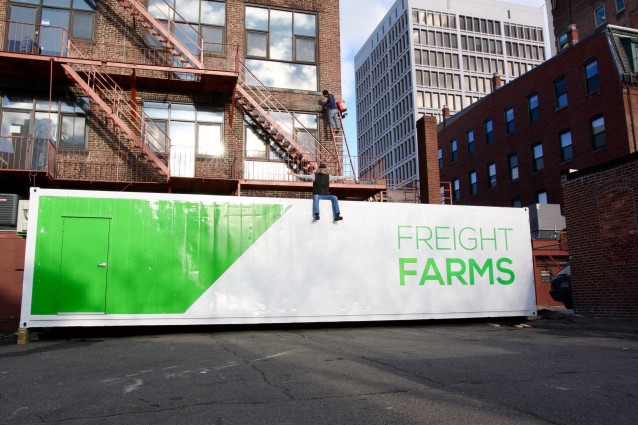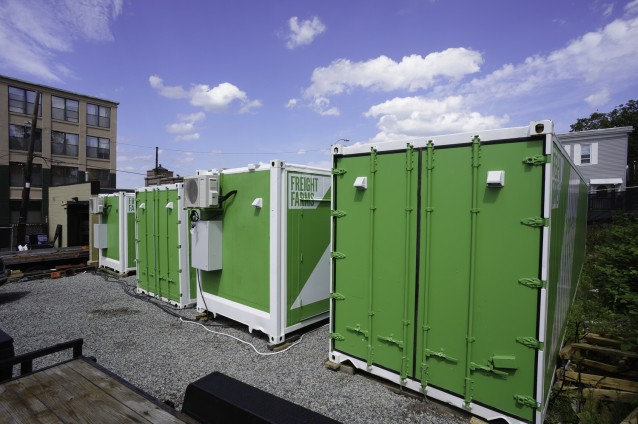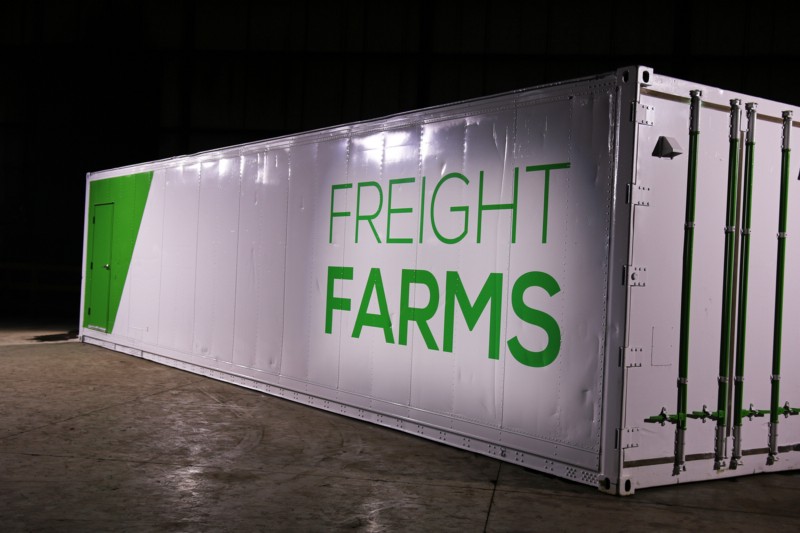When Michael Bissanti opened Four Burgers in Cambridge, Massachusetts in 2008, he knew he wanted to create a fast food restaurant with a strong sense of sustainability. Initially, that meant procuring only ingredients deemed natural, as well as sourcing from organic and local farms. But Bissanti quickly realized that the “natural” label wasn’t a panacea for a sustainable food system — and so he went looking for a way to bring sustainable, local ingredients even closer to his kitchen.
Today, those ingredients could hardly be closer — Bissanti only needs to walk out the back door of his restaurant to pick all the fresh lettuce, arugula, mustard greens, and herbs he needs. Even in the cold Boston winters, Bissanti is merely feet away from fresh produce, in spite of the fact that his restaurant is located right in the middle of an urban thoroughfare between Harvard and MIT.
That’s because Bissanti is one of more than 50 farmers across the country growing produce in refrigerated shipping containers known as Leafy Green Machines, created by the Boston-based start-up Freight Farms. Outfitted with vertical hydroponics and LED light systems, the Leafy Green Machines are 320 square-foot self-contained farming units that can grow as much produce as two acres of farmland using less water per day than the average American needs for a single shower.

Freight Farms cofounder Brad McNamara first got the idea for creating farms in shipping containers while working in rooftop farm consulting throughout Boston as a graduate student. McNamara was trying to figure out ways to make rooftop hydroponic farming more efficient — but realized the potential for highly-efficient local farming spread well beyond Boston’s rooftops.
“One of the big issues we saw when we were looking at greenhouses and rooftop space was that every project is a unique custom piece of equipment and a very complex system,” McNamara told ThinkProgress. Despite a wealth of research describing the ideal conditions for growing crops in hydroponic systems — systems that use nutrient-rich water instead of soil — McNamara and his partner were having a hard time figuring out how to make those conditions replicable regardless of a farm’s location.
“The big issue was replicating those conditions simply and easily so that someone who is not an engineer, a plumber, an electrician and a horticulturist would be able to grow those plants,” he said.
The traditional rooftop greenhouses are also expensive, costing between $1 million to $2 million to get started. A Freight Farms unit, by comparison, costs around $80,000.
All Freight Farms units are built in repurposed 40-foot insulated shipping containers. Everything from water to the LED lights in the units are digitally controlled, and each unit is also a Wifi hotspot, connected to the network of Freight Farm units across the country.
“Everything is fully contained within the module so that it lands as a turnkey product, ready to grow,” McNamara said. “From day one, people can start seeds and get going.”

The symbolism of a business model that takes refrigerated shipping containers used to carry food all across the globe — burning fossil fuels that contribute to global warming in the process — and turns them into hotspots for the local food movement isn’t lost on McNamara.
“The insulated and refrigerated containers are a big part of the cold food supply chain that has made the global centralization of food production possible, and that’s a big problem,” he said. “But we are able to use them to make local food production possible in any location.”
But beyond symbolism, McNamara boasts about the Leafy Green Machine’s ability to take a hyper-local food system and, using technology, make it both extremely efficient and ultra-connected.
Freight Farms users can control their shipping containers remotely, uploading information to a network that is shared among all users. That means that the system is constantly updating based on the best available data, and constantly adapting to what individual farmers are doing. If a farmer decides to grow cucumbers in her farm, for instance, her successes and failures are turned into metrics that are then shared with the other users — through trial and error, farmers themselves are able to workshop the best temperature, water footprint, or nutrient profile required to most efficiently grow a new crop.
“Every farmer that becomes a Freight Farmer now is exponentially better than somebody who started just a few months ago, because they are building on the backs of 40 or 50 people who have been doing it now for a few years,” McNamara said. “Rather than us just conducting research and development back in Boston, we’ll actually work with the network of farmers and see what results they are getting.”

Maximizing the efficiency of a Freight Farms unit — and thereby reducing the amount of energy and water required to grow crops throughout the system — has been a priority for McNamara since the company began. Right now, McNamara said, a single unit uses around 10 gallons of water per day, and between 30,000 to 35,000 kilowatt hours of energy per year. While the water footprint is fairly small — the average American shower uses about two gallons of water a minute — the energy footprint is three times the electricity used annually by an average American home.
Freight Farms units are still at the mercy of the grid — a farmer typically can’t choose whether the energy needed to power the unit comes from a low-carbon option like wind or solar, or from a carbon-polluting option like coal. But McNamara has been working on making the units themselves more energy efficient — between 2014 and 2015, Freight Farms worked to increase the system’s efficiency by 30 percent. They didn’t quite get there, topping out at a 26 percent increase in efficiency, but McNamara remains committed to the idea of streamlining the system as much as possible. That means including things like external monitors that can sense the outside temperature and use small, low-energy fans to pump cold or warm air into the container, which can lower or raise the temperature inside the container without using much energy.
The biggest challenge anybody is going to have is trying to find a way to use all of the stuff it grows
For now, most of the 50 or so Freight Farms units currently in operation are located in urban settings, or on college campuses. A single unit can produce between 5,000 and 6,000 plants — enough for start-up farmers to supply multiple clients, from restaurants to farmers markets, with fresh produce year-round.
“The biggest challenge anybody is going to have is trying to find a way to use all of the stuff it grows, because the capacity is really amazing,” Cambridge-chef Bissanti said.
Because Freight Farms units are impermanent structures, they also circumvent a common barrier to urban farming — the thorny bureaucracy of restrictive zoning laws. In Boston, which two years ago passed a law meant to make zoning easier for urban farming, that’s less of an issue, but in cities without urban-farm-friendly zoning laws, the temporary nature of a Freight Farms container can help would-be urban farming get started without too much red tape. And because they are self-contained units, the shipping container farms can open up corners of the urban landscape that would otherwise be off-limits to farming — empty parking lots, alleys behind tall buildings, and spaces under overpasses all become potential sites for a farm regardless of their soil health or proximity to heavy traffic.
But McNamara doesn’t necessarily see Freight Farms supplanting the traditional urban farm or rooftop greenhouse — nor does he see Freight Farms as being limited to an urban setting. He envisions a future where small- to medium-sized farms have one or two Freight Farms units on the premises, allowing them to grow specialty crops like herbs and vegetables while reserving cropland for whatever commodity crop naturally grows best there.
“Between [traditional farming] and greenhouses, all of these solutions have a perfect place,” he said. “Freight Farms just allows our perfect place to have a much wider scope.”
Freight Farms units, since they are insulated from the elements, also allow farmers to grow fresh produce year-round. As Winter Storm Jonas barreled down on the East Coast in late January, a Freight Farms team in Baltimore bragged on Facebook about how they could still manage to be farming in the midst of a snowstorm.
Neither snow nor rain nor heat nor gloom of night stays these #Farmers from the swift completion of their appointed…
Posted by Urban Pastoral on Friday, January 22, 2016
To Bissanti, who grew up on a working family farm, the insulated nature of a Freight Farms unit means more than just the ability to keep farming in a blizzard — it offers the opportunity to keep farming in a controlled environment even as climate change makes weather increasingly variable.
“We are having heat waves and we’ve having droughts and we’re having flooding. That impacts the farmers greatly,” he said. “A system like this, because it’s so contained, because it grows 365-days a year regardless of the weather outside, you’ve created this perfect environment that is completely sheltered from all of that.”
